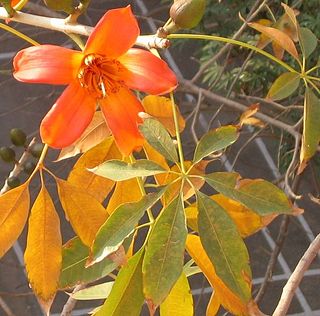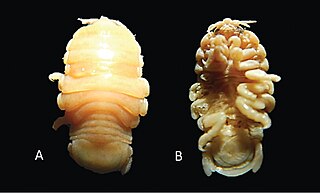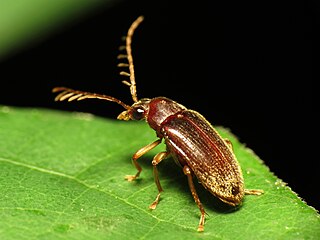
Malpighia emarginata is a tropical fruit-bearing shrub or small tree in the family Malpighiaceae.

Libinia emarginata, the portly spider crab, common spider crab or nine-spined spider crab, is a species of stenohaline crab that lives on the Atlantic coast of North America.

Bombax is a genus of mainly tropical trees in the mallow family. They are native to western Africa, the Indian subcontinent, Southeast Asia, and the subtropical regions of East Asia and northern Australia. It is distinguished from the genus Ceiba, which has whiter flowers.

Olea is a genus of flowering plants in the family Oleaceae. It includes 12 species native to warm temperate and tropical regions of the Middle East, southern Europe, Africa, southern Asia, and Australasia. They are evergreen trees and shrubs, with small, opposite, entire leaves. The fruit is a drupe. Leaves of Olea contain trichosclereids.

The Algodones Dunes is a large sand dune field, or erg, located in the southeastern portion of the U.S. state of California, near the border with Arizona and the Mexican state of Baja California. The field is approximately 45 miles (72 km) long by 6 miles (9.7 km) wide and extends along a northwest-southeast line that correlates to the prevailing northerly and westerly wind directions. The name "Algodones Dunes" refers to the entire geographic feature, while the administrative designation for that portion managed by the Bureau of Land Management is the Imperial Sand Dunes Recreation Area. In 1966, Imperial Sand Hills was designated as a National Natural Landmark by the National Park Service. The Algodones Dunes are split into many different sections. These sections include Glamis, Gordon's Well, Buttercup, Midway, and Patton's Valley. Although the Arabic-derived Spanish word algodones translates to "cotton plants", the origin of the toponym is unknown.

Prunus emarginata, the bitter cherry or Oregon cherry, is a species of Prunus native to western North America, from British Columbia south to Baja California, and east as far as western Wyoming and New Mexico. It is often found in recently disturbed areas or open woods on nutrient-rich soil.

Oraesia emarginata is a species of moth of the family Erebidae first described by Johan Christian Fabricius in 1794. It is found in Australia, New Caledonia, Indonesia, New Guinea, Pakistan, the Philippines, India, Sri Lanka, Sulawesi, Taiwan, China, Japan, Korea and Nepal as well as Eritrea, Ethiopia, Kenya, Namibia, Nigeria, South Africa, Tanzania, the Gambia, Uganda, Oman and Yemen.

Emarginata is a genus of birds in the Old World flycatcher family Muscicapidae that occur in southern Africa.
Stictiella formosa is a species in the order Hymenoptera, in the class Insecta ("insects"). The distribution range of Stictiella formosa includes Central America and North America.

Stictiella is a genus of sand wasps in the family Crabronidae. There are at least 14 described species in Stictiella.

Cycloneda is a genus of spotless lady beetles in the family Coccinellidae. There are more than 20 described species in Cycloneda.

Elthusa is a genus of isopods in the family Cymothoidae, with 40 described species.

Thyanta is a genus of stink bugs in the family Pentatomidae. There are about 19 described species in Thyanta.

Ptilodactyla is a genus of toe-winged beetles in the family Ptilodactylidae. There are more than 30 described species in Ptilodactyla.
Obolopteryx emarginata, the spoon-tail short-wing katydid is the type species of phaneropterine katydids of its genus. It is found in North America.
Mezira emarginata is a species of flat bug in the family Aradidae. It is found in Central America and North America.

Stenelytrana emarginata is a species of flower longhorn in the beetle family Cerambycidae. It is found in North America.
Monotoma emarginata is a species of root-eating beetle in the family Monotomidae. It is found in North America.
Pentispa is a genus of tortoise beetles and hispines in the family Chrysomelidae. There are more than 20 described species in Pentispa.
Cordilura emarginata is a species of dung fly in the family Scathophagidae.














